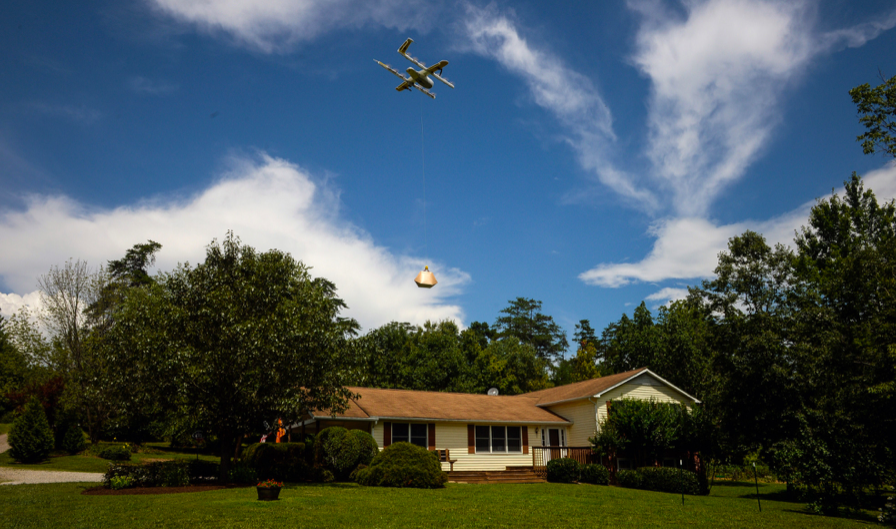
A Wing Aviation drone delivers a package to a home during a demo in Blacksburg, Virginia. | Credit: Bloomberg
Alphabet Inc. subsidiary Wing Aviation on Tuesday became the first drone delivery company to be awarded air carrier certification from the Federal Aviation Administration (FAA). With the certification, Wing Aviation now has the same certifications as smaller airlines and can turn its tests into a commercial service that delivers goods from local businesses to homes.
The approval grants Wing permission to conduct flights beyond visual line of sight and over people, Wing says. The company will start commercial deliveries in Blacksburg, Virginia later in 2019. Wing spun out of Alphabet’s X research division in July 2018.
“This is an important step forward for the safe testing and integration of drones into our economy,” said U.S. Secretary of Transportation, Elaine L. Chao, who made the announcement. “Safety continues to be our Number One priority as this technology continues to develop and realize its full potential.”
Part of the approval process required Wing Aviation to submit evidence that its operations are safe. Wing’s drones have flown more than 70,000 test flights and made more than 3,000 deliveries. Wing says it submitted data that shows “delivery by Wing carries a lower risk to pedestrians than the same trip made by car.”
PwC estimates the total addressable market for commercial drones is $127.3 billion. That includes $45.2 billion in infrastructure, $32.4 billion in agriculture, $13 billion in transport and $10.5 billion in security.
Wing’s electric drones are powered by 14 propellers and can carry loads of up to 1.5 kilograms (3.3 pounds). Wing’s drones can fly up to 120 kilometers (about 74.5 miles) per hour and can fly up to 400 feet above the ground. Wing’s drones convert GPS signals into latitude and longitude to determine location and speed.
The drones also have a number of redundant systems on board for operation and navigation, among them a downward-facing camera used as a backup to GPS navigation. If the GPS is unavailable for any reason, the drone uses data from the camera to measure speed, latitude and longitude in its place. The camera is used exclusively for navigation, it doesn’t capture video and is not available in real time.
Drone regulations still don’t permit most flights over crowds and urban areas. This will, of course, limit where Wing can operate. But the company said it plans to start charging soon for deliveries in Blacksburg and eventually apply for permission to expand to other regions.
The first of Wing’s drone deliveries were completed in 2014 in Queensland, Australia, where everything from dog treats to a first-aid kit were delivered to farmers. Two years later, Wing’s drones delivered burritos to Virginia Tech students. “Goods like medicine or food can now be delivered faster by drone, giving families, shift workers, and other busy consumers more time to do the things that matter,” Wing Aviation writes in a blog. “Air delivery also provides greater autonomy to those who need assistance with mobility.”
Just a couple weeks prior to the FAA certification, Wing made its first drone delivery in Cranberry, Australia after recently receiving approval from the country’s Civil Aviation Authority. To start, Wing service will be available to 100 homes and will be slowly expanded to other customers.
Wing was first known as “Project Wing” when it was introduced in 2014. Google X made the announcement via the video below, which shows early test flights in Queensland.
Wing is also launching its first European drone delivery service in Finland this spring. In its tests in Australia, the average Wing delivery was completed in 7 minutes 36 seconds, according to a spokeswoman.
In June 2016, Wing worked with NASA and the FAA to explore how to manage drones. Wing demonstrated its Unmanned Traffic Management (UTM), real-time route planning, and airspace notifications. Wing’s UTM platform is designed to support the growing drone industry by enabling a high volume of drones to share the skies and fly safely over people, around terrain and buildings, and near airports, which remain hurdles before drone deliveries become commonplace in the US. A DJI drone was recently spotted illegally flying over Fenway Park where a ban should have been in place.
Wing says on its website, “we’re working with the FAA on the Low Altitude Authorization and Notification Capability (LAANC) system in the United States and with the Civil Aviation Safety Authority (CASA) in Australia to develop federated, industry-led solutions to safely integrate and manage drones in low-altitude airspace.”